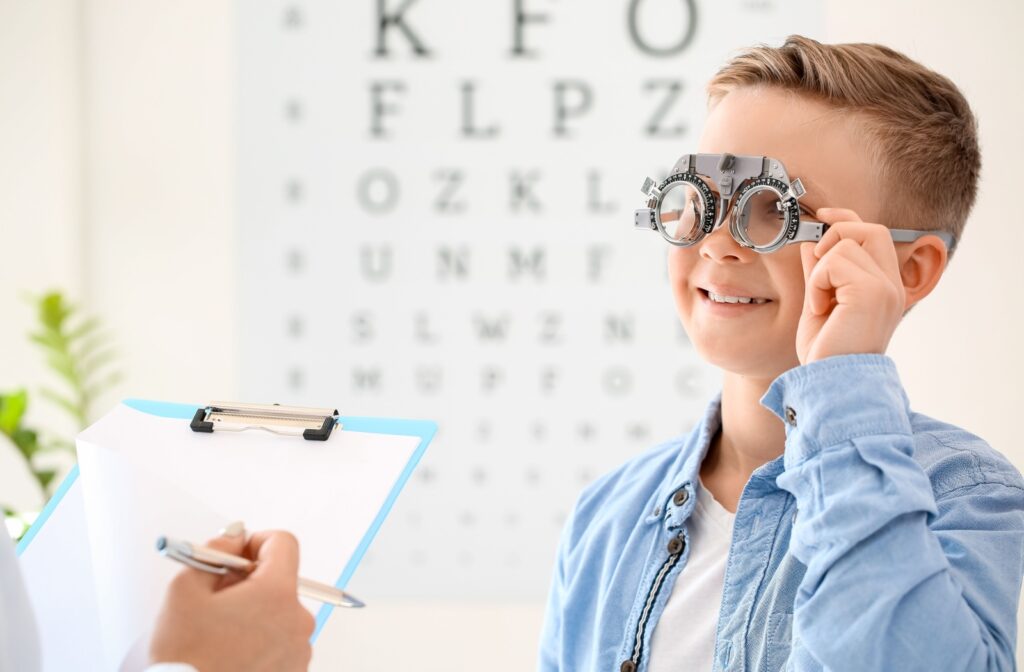When was the last time you thought about your vision? For many of us, clear eyesight is something we take for granted. But if you’re a parent noticing your child squinting at the chalkboard or an adult struggling to read a menu in dim lighting, understanding your vision is important.
The two most common causes of blurry vision are myopia and hyperopia. While these terms may sound similar, they affect your vision in different ways. Myopia (nearsightedness) makes distant objects appear blurry, while hyperopia (farsightedness) causes nearby objects to look unclear.
What is Myopia?
Commonly referred to as nearsightedness, myopia occurs when objects appear clear, but distant objects look blurry. This is caused by the shape of the eye being too elongated or the cornea being overly curved. These physical changes cause light rays to focus in front of the retina instead of directly on it.
Symptoms of Myopia
- Difficulty seeing distant objects clearly, such as street signs or a whiteboard in class
- Squinting to focus on far-away objects
- Eye strain or fatigue, especially using activities like driving or watching television
- Headaches after trying to focus on distant visuals
- Worsened vision at night, also known as night myopia
How Common Is Myopia?
Myopia is becoming increasingly prevalent worldwide, affecting approximately 30% of the global population. Factors such as prolonged screen time, reduced outdoor activities, and extensive near-work tasks like reading or gaming have been linked to the rise in myopia, especially in children.
What is Hyperopia?
Also known as farsightedness, hyperopia is when distant objects are clear, but close-up objects are difficult to focus on. This condition occurs when the eyeball is too short or the cornea lacks sufficient curvature, causing light to focus behind the retina.
Symptoms of Hyperopia
- Blurred vision when focusing on nearby objects, such as books or screens
- Difficulty with close work like reading or writing
- Eyestrain, particularly after extended periods of close-up activities
- Frequent headaches due to overexertion of the eye’s focusing muscles
How Common Is Hyperopia?
Hyperopia is a common vision condition that often goes unnoticed, as many people may have it without realizing it. It typically becomes a concern only when it starts affecting daily activities, causing blurred vision, eye strain, or difficulty focusing on close objects.
Similarities Between Myopia & Hyperopia
Before we highlight their differences, it’s worth noting how these two conditions are similar:
- Blurred vision: Both myopia and hyperopia result from refractive errors, where the shape of the eye prevents proper light focus on the retina.
- Genetics: Both conditions often run in families, increasing the likelihood of developing them if a parent or sibling has it.
- Eye discomfort: Left untreated, both conditions can lead to eyestrain, headaches, or complications like amblyopia (lazy eye).
- Corrective options: Both can be managed with glasses, contact lenses, or surgical procedures.

What’s the Difference Between Myopia & Hyperopia
Myopia (nearsightedness) and hyperopia (farsightedness) differ in how they affect vision. Myopia causes distant objects to appear blurry while close-up vision remains clear, whereas hyperopia makes nearby objects appear blurry while distant vision stays sharp.
These differences are largely due to the shape of the eye. Myopia eyes are typically elongated, while hyperopic eyes are shorter. Myopia often develops in childhood, while hyperopia can occur at any age, including adulthood. Common symptoms of myopia include squinting and difficulty seeing faraway objects clearly, while hyperopia often leads to eyestrain and trouble focusing on close-up tasks.
How Myopia & Hyperopia Affect Children
For children, vision is especially important for learning, development, and overall quality of life. Both conditions can have a significant impact if not addressed early.
Hyperopia in Children
Mild hyperopia is common in young children and often resolves naturally as their eyes mature. However, severe hyperopia can affect reading, delay hand-eye coordination development, and lead to conditions like crossed eyes (strabismus) or lazy eye (amblyopia).
Myopia in Children
Myopia often starts in school-aged children and tends to worsen during adolescence. If left untreated, it can limit their ability to see the classroom board or participate in sports. Regular eye exams are essential to monitor and manage myopia progression.
Treating Nearsightedness & Farsightedness
If you or your child experience blurry vision, consult an eye care professional. Here are common treatment options:
Glasses & Contact Lenses
Glasses are the most straightforward and popular correction for both conditions. Myopia is corrected with concave lenses to help focus light directly onto the retina. Hyperopia is managed with convex lenses to remedy the focus of light rays.
For an alternative to glasses, contact lenses offer convenience, wider visual fields, and are often preferred by active individuals.
Orthokeratology (Ortho-K)
This treatment involves wearing specially designed contact lenses overnight to temporarily reshape the cornea, improving vision during the day. Ortho-K is commonly used to slow myopia progression in children.
Refractive Surgery
Procedures like LASIK and PRK permanently reshape the cornea and offer long-term solutions for adults with myopia or hyperopia.
Lifestyle Adjustments
Adopting healthy habits can help manage these conditions:
- Reduce screen time to minimize eye strain.
- Ensure proper lighting when reading or working.
- Encourage outdoor play for children to reduce myopia progression.
Take Control of Your Vision Today
Don’t ignore the issue whether you or your child struggles with near or far vision. Understanding the differences between myopia and hyperopia is the first step toward better eye health.
At White Oaks Optometry, we’re here to help. Whether it’s your child’s first eye exam or your own next steps toward corrective solutions, our team is dedicated to providing family-friendly, trustworthy care. Contact us today to book a comprehensive eye exam and see beyond the blurry lines.



